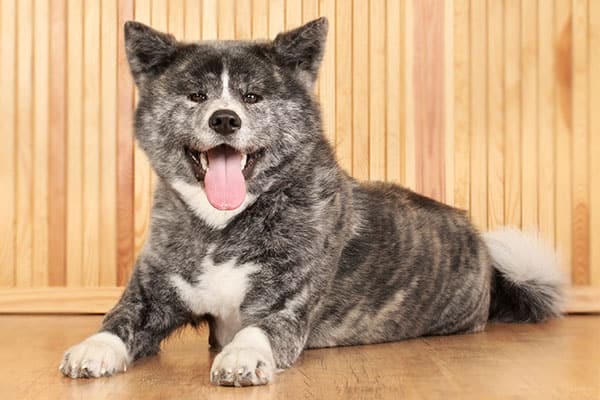On occasion, our posts contain affiliate links. However, we only recommend products that we truly believe in. For more information, visit my privacy policy page.
Phew, this website is a labor of love and largely a one-woman show so unless indicated, all articles written by J.Tsukamoto
The Akita Inu is an impressive dog possessing a large head along with a formidable body.
Even more impressive is the varieties of coats Akita Inus come in.
From red to white, fawn to brindle – Akita Inus has them all.
And one of the coolest and most unique coat colors is the brindle coat.
Comprising about 30% of Akita Inu coats, the brindle coat can vary in shades including red, silver, and black brindle.
While Akita Inus are already known for their impressive size and guard dog abilities, brindle Akita Inus takes that toughness to the next level!
What Is a Brindle Akita Inu?
The term brindle refers to the coloring of the Akita’s coat.
This coat coloring is purely the result of genetics.
In the dog world, brindle coat colors are not that common and virtually impossible to test for.
Brindle coats are known to have a “tiger-like” pattern with interesting markings in a wide range of colors.
This means that a brindle-coated Akita will undoubtedly have a unique coat pattern this is entirely him or her.
Characteristics of the Brindle Akita Inu Coat
Brindle Akita coats possess a unique coloration consisting of black and brown stripes that are typically darker and have a tiger-like appearance.
The base color for a brindle Akita can either be white or red.
The brindle markings spread across the back, torso, and face.
Akita breed standards define the brindle pattern as fine, clearly delineated dark streaks or stripes that are layered over a lighter background color.
Additionally there are three subtypes of brindle coats which include red brindle (akatora), black brindle (kurotora), and silver brindle (shimofuri).
Following AKC standards, brindle Akita Inus can be self-masked or possess a white blaze that extends up the muzzle.
The preferred brindle pattern possess a coat that consists of six points of white markings, known by the Japanese as “roppaku”. These markings can range in various intensities and be found on the muzzle, four paws, and the tip of the tail.
Urajiro should also be present on brindles appearing on the neck, abdomen, tail, inside of legs and beneath the jaw.
In brindles as well as a red a fault is when a white blaze extends from the muzzle all the way to the back of the head, referred as “hachiware” in Japanese
While Shiba Inus, huskies, and Chow Chows are known for their double coat – the Akita Inu has three coats!
The outer coat consists of coarse, straight guard hairs that stand off the body and repels water and dirt. The two inner coats serve as insulating under coats with one coat thicker and softer than the other.
The guard hair on the Akita’s tail are much longer and fuller than the body coat.
Health Considerations for Brindle Akita Inus
Brindle-coated Akita Inus do not suffer from health issues due to their brindle coat.
Instead, brindle Akitas have the same health issues as all Akitas.
Health issues to look out for include hypothyroidism, retinal atrophy, and bloat.
Additionally, brindle Akita Inus have the same life spans as Akitas which is roughly 10 – 12 years which is actually pretty decent for such a large sized dog.
Caring For A Brindle-Coated Akita Inu
With their triplex of coats, Akita Inus are massively heavy shedders.
Thankfully, the heavy shedding occurs only twice a year.
During heavy shedding, or coat blowing seasons, Akitas should be brushed and groomed regularly.
There’s a variety of different grooming tools that will make grooming your massively shedding Akita much easier.
It’s important to begin the grooming process during early puppyhood so that your Akita will not go into fits during grooming sessions as an adult.
Proper and consistent socialization is a must do for large and powerful dogs like Akita Inus.
Brindle Akita Inu and Red Akita Inu
Interesting Facts About The Brindle-Coated Akita Inu
The brindle coat color is caused by a gene that is somewhat rare and virtually impossible to DNA test for.
Although soft brindle-coated color Akitas are adorable – the preferred Akita coat should be stiffer and tougher. This type of coat protects the Akita from excessive wetness that will help to keep them warm during the winter months.
The brindle Akita Inu is more common in American Akita Inus versus Japanese Akita Inus. This is due to the fact that American Akita Inus were crossbred to brindle type dogs like German Shepherds in the past.
At one time in past history, the Akita could only be owned by the Japanese Imperial family and the ruling aristocracy. The care and feeding of Akita Inus were elaborately carried out, sometimes in special ceremonies where special leashes were used to denote the Akita’s as well as their owners “rank”.
Thanks for visiting Myfirstshiba.com! We do our very best in providing our readers with awesome content about our beloved Shiba Inu breed. Some of our articles include reviews and recommendations to our favorite products. We do occasionally earn commissions from certain affiliate links that help support our work and mission. Thanks again for visiting. Shiba Kisses To All!







